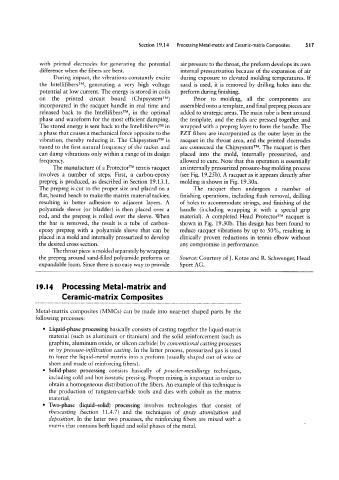Page 537 - 04. Subyek Engineering Materials - Manufacturing, Engineering and Technology SI 6th Edition - Serope Kalpakjian, Stephen Schmid (2009)
P. 537
Section 19.14 Processing Metal-matrix and Ceramic-matrix Composites SIT
with printed electrodes for generating the potential air pressure to the throat, the preform develops its own
difference when the fibers are bent. internal pressurization because of the expansion of air
During impact, the vibrations constantly excite during exposure to elevated molding temperatures. If
the Intellifibersm, generating a very high voltage sand is used, it is removed by drilling holes into the
potential at low current. The energy is stored in coils preform during finishing.
on the printed circuit board (Chipsystemm) Prior to molding, all the components are
incorporated in the racquet handle in real time and assembled onto a template, and final prepreg pieces are
released back to the lntellifibersw, in the optimal added to strategic areas. The main tube is bent around
phase and waveform for the most efficient damping. the template, and the ends are pressed together and
The stored energy is sent back to the Intellifibersm in wrapped with a prepreg layer to form the handle. The
a phase that causes a mechanical force opposite to the PZT fibers are incorporated as the outer layer in the
vibration, thereby reducing it. The Chipsystemm is racquet in the throat area, and the printed electrodes
tuned to the first natural frequency of the racket and are connected the Chipsystemm. The racquet is then
can damp vibrations only within a range of its design placed into the mold, internally pressurized, and
frequency. allowed to cure. Note that this operation is essentially
The manufacture of a Protector” tennis racquet an internally pressurized pressure-bag molding process
involves a number of steps. First, a carbon-epoxy (see Fig. 19.25b). A racquet as it appears directly after
prepreg is produced, as described in Section 19.13.1. molding is shown in Fig. 19.30a.
The prepreg is cut to the proper size and placed on a The racquet then undergoes a number of
flat, heated bench to make the matrix material tackier, finishing operations, including flash removal, drilling
resulting in better adhesion to adjacent layers. A of holes to accommodate strings, and finishing of the
polyamide sleeve (or bladder) is then placed over a handle (including wrapping it with a special grip
rod, and the prepreg is rolled over the sleeve. When material). A completed Head Protectorm racquet is
the bar is removed, the result is a tube of carbon- shown in Fig. 19.30b. This design has been found to
epoxy prepreg with a polyamide sleeve that can be reduce racquet vibrations by up to 50%, resulting in
placed in a mold and internally pressurized to develop clinically proven reductions in tennis elbow without
the desired cross section. any compromise in performance.
The throat piece is molded separately by wrapping
the prepreg around sand-filled polyamide preforms or Source: Courtesy of ]. Kotze and R. Schwenger, Head
expandable foam. Since there is no easy way to provide Sport AG.
l9.I4 Processing Metal-matrix and
Ceramic-matrix Composites
Metal-matrix composites (MMCs) can be made into near-net shaped parts by the
following processes:
° Liquid-phase processing basically consists of casting together the liquid-matrix
material (such as aluminum or titanium) and the solid reinforcement (such as
graphite, aluminum oxide, or silicon carbide) by conventional casting processes
or by pressure-in}Qltmtion casting. In the latter process, pressurized gas is used
to force the liquid-metal matrix into a preform (usually shaped out of wire or
sheet and made of reinforcing fibers).
° Solid-phase processing consists basically of powder-metallurgy techniques,
including cold and hot isostatic pressing. Proper mixing is important in order to
obtain a homogeneous distribution of the fibers. An example of this technique is
the production of tungsten-carbide tools and dies with cobalt as the matrix
material.
° Two-phase (liquid-solid) processing involves technologies that consist of
rheocasting (Section 11.4.7) and the techniques of spray atomization and
deposition. In the latter two processes, the reinforcing fibers are mixed with a
matrix that contains both liquid and solid phases of the metal.

